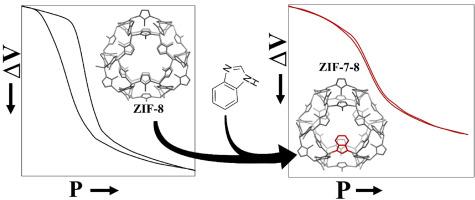Effect of linker hybridization on the wetting of hydrophobic metal-organic frameworks
IF 4.8
3区 材料科学
Q1 CHEMISTRY, APPLIED
引用次数: 0
Abstract
Wetting-dewetting of nanoporous materials is of key importance for a wide range of natural and technological cases, which include separation, chromatography, ionic channels. Heterogeneous lyophobic systems (HLS) consisting of a lyophobic nanoporous material and a non-wetting liquid are attractive for thermomechanical energy storage, conversion and dissipation under pressure/temperature variations. In recent years, metal-organic frameworks (MOFs) are entering many fields, including those mentioned above due to their wide structural diversity, structural flexibility and high tunability. In this work, we investigate the hitherto unexplored effects of forced wetting (intrusion-extrusion) of a hybrid mixed-linker ZIF-7-8 MOF (Zn-methylimidazole0.794–benzimidazole0.206) with water. Surprisingly, despite its structural similarity to ZIF-8, the hybrid ZIF-7-8 MOF demonstrates a non-hysteretic water intrusion-extrusion cycle that is in strong contrast to both ZIF-8 and ZIF-7 MOFs, which have pronounced intrusion-extrusion hysteresis. We used a combination of high-pressure intrusion-extrusion experiments, neutron diffraction structural analysis and atomistic simulations to put forward several hypotheses regarding the observed transformation from shock absorber/bumper behavior of ZIF-8 and ZIF-7 to molecular spring behavior of hybrid ZIF-7-8. These results open a new route for tuning the intrusion-extrusion (wetting-dewetting) hysteresis for numerous applications.

连接体杂化对疏水性金属有机框架润湿性的影响
纳米多孔材料的润湿-脱水对各种自然和技术情况都至关重要,其中包括分离、色谱、离子通道等。由疏水性纳米多孔材料和非润湿液体组成的异质疏水性体系(HLS)在压力/温度变化下的热机械能存储、转换和耗散方面具有吸引力。近年来,金属有机框架(MOFs)因其广泛的结构多样性、结构灵活性和高可调性正在进入包括上述领域在内的许多领域。在这项工作中,我们研究了混合连接剂 ZIF-7-8 MOF(Zn-甲基咪唑 0.794-苯并咪唑 0.206)与水的强制润湿(侵入-挤出)效果,这是迄今为止尚未探索过的。令人惊讶的是,尽管与 ZIF-8 的结构相似,混合 ZIF-7-8 MOF 却表现出了非滞后的水侵入-挤出循环,这与 ZIF-8 和 ZIF-7 MOF 形成了强烈对比,后者具有明显的侵入-挤出滞后。我们结合高压侵入-挤出实验、中子衍射结构分析和原子模拟,就观察到的从 ZIF-8 和 ZIF-7 的减震器/缓冲器行为到混合 ZIF-7-8 的分子弹簧行为的转变提出了几种假设。这些研究结果为调整侵入-挤出(润湿-脱湿)滞后开辟了一条新途径,可用于多种应用。
本文章由计算机程序翻译,如有差异,请以英文原文为准。
求助全文
约1分钟内获得全文
求助全文
来源期刊

Microporous and Mesoporous Materials
化学-材料科学:综合
CiteScore
10.70
自引率
5.80%
发文量
649
审稿时长
26 days
期刊介绍:
Microporous and Mesoporous Materials covers novel and significant aspects of porous solids classified as either microporous (pore size up to 2 nm) or mesoporous (pore size 2 to 50 nm). The porosity should have a specific impact on the material properties or application. Typical examples are zeolites and zeolite-like materials, pillared materials, clathrasils and clathrates, carbon molecular sieves, ordered mesoporous materials, organic/inorganic porous hybrid materials, or porous metal oxides. Both natural and synthetic porous materials are within the scope of the journal.
Topics which are particularly of interest include:
All aspects of natural microporous and mesoporous solids
The synthesis of crystalline or amorphous porous materials
The physico-chemical characterization of microporous and mesoporous solids, especially spectroscopic and microscopic
The modification of microporous and mesoporous solids, for example by ion exchange or solid-state reactions
All topics related to diffusion of mobile species in the pores of microporous and mesoporous materials
Adsorption (and other separation techniques) using microporous or mesoporous adsorbents
Catalysis by microporous and mesoporous materials
Host/guest interactions
Theoretical chemistry and modelling of host/guest interactions
All topics related to the application of microporous and mesoporous materials in industrial catalysis, separation technology, environmental protection, electrochemistry, membranes, sensors, optical devices, etc.
 求助内容:
求助内容: 应助结果提醒方式:
应助结果提醒方式:


